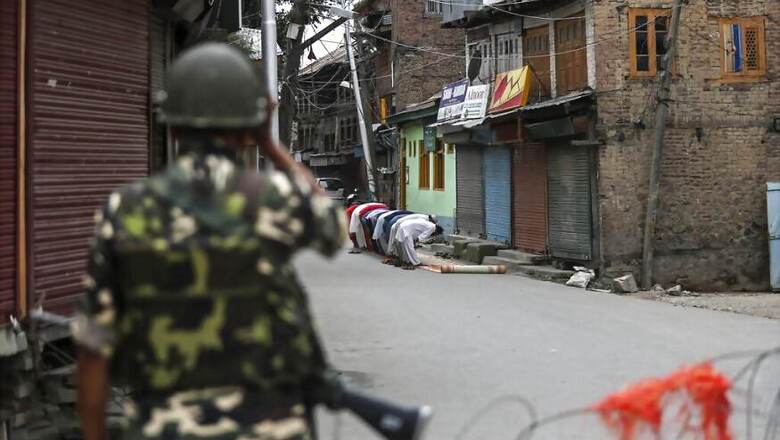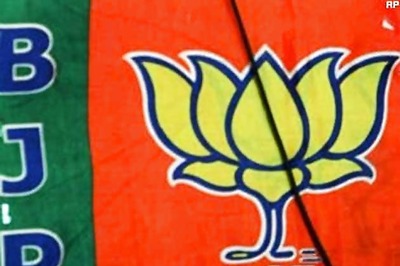
views
Eight hundred people, perhaps more, filled the Eidgah ground in the small town of Arwani on Monday morning, for funeral prayers to mourn the killing of Hizb-ul-Mujahideen jihadist Owais Ahmad Malik — ignoring both a police ban on public gatherings and the lockdown imposed to contain the coronavirus pandemic in southern Kashmir, which is emerging as the region’s worst-affected area.
Fuelled by ever-more effective intelligence generated by the Jammu Kashmir Police, Indian forces have brought the Hizb — once the region’s most feared jihadist group — to its knees across its south Kashmir strongholds.
Nine Hizb terrorists have been shot dead in fire engagements that ran over the weekend alone, bringing the total numbers of jihadists killed so far this year to over 70.
Lacking in weapons, ammunition, funding, training and leadership, the Hizb still continues, however, to cast a grim spell over the minds of many young men in southern Kashmir.
From local accounts and police records, it is clear that Arwani-born Malik was an improbable local hero. Lacking the religious or ideological credentials of an earlier generation of jihadists, his last significant run-in with police came last year, when he was held while peddling marijuana — widely grown in south Kashmir’s sun-drenched Pir Panjal range. In his home town, two local residents told News18, he was once known for involvement in minor crime.
But hundreds of young people threw stones at police and Indian Army soldiers when they surrounded Malik in the village of Reban-Zainapora, near Shopian, in a desperate effort to help him escape.
Though clashes like these were common from 2014 to 2016, they slowly diminished and then disappeared after Kashmir’s special constitutional status was revoked in August. Ever since March, though, stone-throwing mobs have confronted counter-terrorism operations with increasing frequency.
In 2016, police sources say, Malik had developed ties with local Hizb cadre, forged through participation in street-battles with police during the massive Islamist-led protests which swept southern Kashmir, after the killing of jihadist Burhan Wani.
Police records suggest Malik fell in with local Hizb commander Ishfaq Itoo — a prominent jihadist who was alleged to have staged four drive-by shootings targeting the police station at Yaripora, a remote village nestled on the lower slopes of the Pir Panjal mountains. The two men are alleged to have run a protection-racket targeting Shopian-region political activists and business people.
In 2018 and 2019, police in the south Kashmir town of Bijbehara filed First Information Reports naming Malik as a member of the Hizb and alleging he was involved in recruiting jihadists.
The three terrorists killed with Itoo and Malik — Bilal Ahmad Bhat, a resident of Hardu Hangeer, Adil Ahmad Mir from Shuch, and Sajjad Wagay from Hangalbuch, all villages near Kulgam in southern Kashmir — were all in their 20s, with no record of prior involvement in terrorism.
From the home where the five jihadists were slain, police found three assault rifles and two pistols. The meagre arsenal shows the cell had been unable to obtain automatic weapons for their new recruits.
“The information we have so far”, a senior police officer told News18, “suggests all three joined the Hizb from March onwards. Families would often report a missing son to authorities, through local legislators or officials, so we’d have a decent idea what was going on — but something seems to have changed”.
In all, police records show, some 15 jihadists shot since January have possessed only a pistol. None of these, police believe, had received any kind of military training.
Even though the Hizb is no longer able to source weapons and ammunition from across the Line of Control, police say, it is drawing legitimacy from mosque networks in south Kashmir. Local mosque committees, often controlled by the Jamaat-e-Islamic, have emerged as providers of support relief to families whose homes have been destroyed in fighting between security forces and terrorists — a task earlier led by government institutions.
“Local administration has disintegrated as a provider of services,” a police officer said, “and religious networks have occupied that space”.
From the story Hizb commander Umer Mohiuddin Dhobi — the leader of a four-man jihadist cell killed in a firefight that began late on Sunday night at Pinjora, near Shopian — it is clear the flow of new recruits is widespread. In addition to Dhobi and his lieutenant Rayees Khan, new recruits Saqlain Amin and Wakil Ahmad — neither of whom were earlier named in police records — were killed in the fighting.
Following the firefight, police found the jihadists had just two assault rifles; the new recruits were equipped only with a self-loading rifle and a pistol.
Police records allege Dhobi was responsible for the murder of three police officers involved in counter-terrorism operations — Nisar Ahmed, Firdous Ahmed and Kulwant Singh — in 2018. He is also alleged to have murdered Sharif Khan, a Rajasthan-based truck driver, in 2019, as the Hizb-ul-Mujahideen attempted to enforce a shutdown of the apple trade across southern Kashmir.
His deputy, Rayees Khan, is listed in police records as having been responsible the murder of police officer Khushboo Jan, shot dead outside her home in Shopian last year, and the execution of Bemnipora resident Tanveer Ahmad. He was also listed as having carried out multiple ambushes targeting troops in the Shopian area.
Though Dhobi and Khan, police records show, joined the Hizb in the autumn of 2018, both encountered Islamist circles in south Kashmir while participating in the street violence two years earlier. The two men killed with them, by contrast, do not have considered joining the Hizb during that time.
Following the 2016 violence, the numbers of Kashmir residents recruited to jihadist groups grew steadily, from 88 that year to 131 in 2017 and 188 in 2018. In 2019, though, the figures dropped again to below 100 — only to reach similar levels again.
Large-scale clashes between protestors and police also ended after Article 370 had been revoked, leading some in New Delhi to believe the decision marked a decisive turning point. Ever since April, though, when the burial of slain Jaish-e-Muhammad terrorist Sajjad Nawab Dar drew hundreds of violent protestors in Sopore, clashes have become increasingly frequent.
“I think it’s fair to say there’s a lot of anger among young people in Kashmir which we’ve been unable to address,” a senior police officer admitted. “The local politicians and administrators who could have reached out to them have been completely discredited after the events August 5.”
Even though the Hizb remains crippled by shortages of funding and weapons, its ethnic Kashmiri jihadists have often been seen to move on to better-resourced groups like the Jaish-e-Muhammad and Lashkar-e-Taiba.
Adil Dar, the suicide-bomber who killed 40 CRPF personnel in 2019 — bringing India and Pakistan to the edge of war — and Adil Hafiz, now being sought by police for his alleged role in an abortive car-bomb strike earlier this month, both began their jihadist journey in the Hizb.



















Comments
0 comment